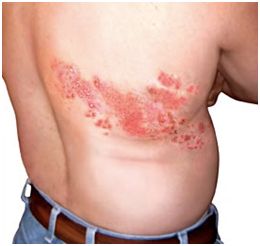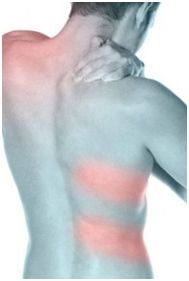Post herpetic neuralgia (PHN) is a complication of shingles, which is caused by the chickenpox (herpes zoster) virus. Even after the acute rash subsides, pain can persist or recur in shingles-affected areas. This condition is known as post herpetic neuralgia.
Post herpetic neuralgia affects your nerve fibers and skin, and the burning pain associated with post herpetic neuralgia can be severe enough to interfere with sleep and appetite.

Shingles rash
Causes
Once you’ve had chickenpox, the virus that caused it remains in your body for the rest of your life. As you grow older, the virus can reactivate. Sometimes this occurs when your body is stressed — because of another infection or due to medications that suppress your immune system.
The result is shingles. Because you have some immunity against the virus, rather than getting a full body rash, the rash occurs in areas of skin supplied by the nerve where the virus is reactivated.
Post herpetic neuralgia occurs if your nerve fibres are damaged during an outbreak of shingles. Damaged fibres aren’t able to send messages from your skin to your brain as they normally do. Instead, the messages become confused and exaggerated, causing chronic, often excruciating pain that may persist for months — or even years.
Symptoms
The signs and symptoms of post herpetic neuralgia are generally limited to the area of your skin where the shingles outbreak first occurred — most commonly in a band around your trunk, usually on just one side of your body.
Signs and symptoms may include:
- Pain – The pain associated with post herpetic neuralgia most commonly has been described as burning, sharp and jabbing, or deep and aching.
- Sensitivity to light touch – People who have post herpetic neuralgia often cannot bear even the touch of clothing on the affected skin, a condition called allodynia.
- Itching and numbness.
- Weakness or paralysis.

Post herpetic neuralgia
Treatment
Although post herpetic neuralgia is generally a self-limited condition, it can last indefinitely. Treatment is directed at pain control while waiting for the condition to resolve. Pain therapy may include multiple interventions, such as topical medications, over-the-counter analgesics, tricyclic antidepressants, anticonvulsants and a number of nonmedical modalities. Occasionally, narcotics may be required.
Low Level Laser Therapy Treatment for Post Herpetic Neuralgia
LLLT is a non-invasive, pain-free, light-based therapy that uses red and infrared light to resolve the inflammatory process and eliminate pain in patients with PHN by stimulating cellular repair.
- In the case of post herpetic pain, LLLT has been proposed to mediate analgesia by releasing local neurotransmitters such as serotonin, promoting the release of endorphins, while simultaneously decreasing prostaglandin E2 and bradykinin levels.
- LLLT has been well documented to stimulate tissue regeneration including angiogenesis, collagen production, muscle and nerve regeneration, cartilage production, and even bone formation.
The inflammation that causes the abnormal stimulation of the nerves in the case of PHN is reduced rapidly with LLLT.
LLLT has no known side effects, is safe and effective.

